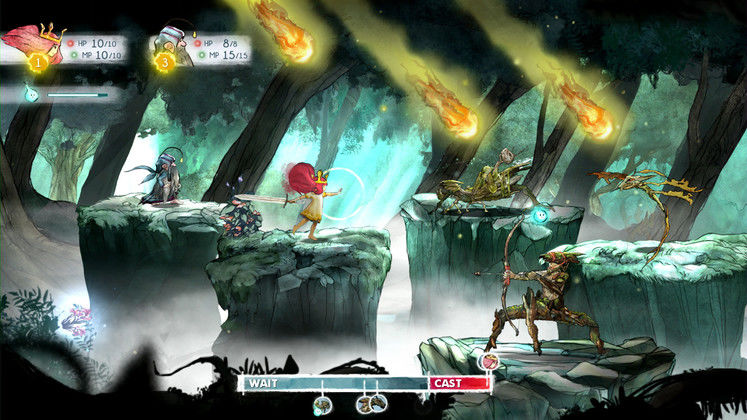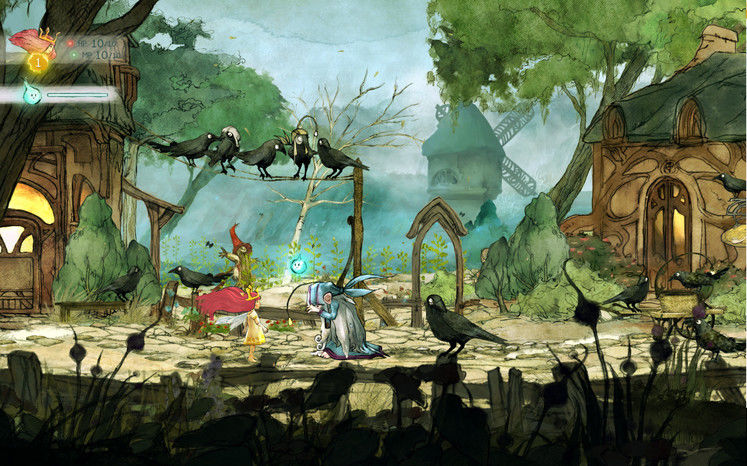Our heroine Aurora is the mischievous daughter of an Austrian Duke. One day she falls ill, slips into a coma and wakes to find herself transported to Lemuria. To return home all she has to do is recover Lemuria's Sun, Moon and Stars, stolen by the mysterious and nefarious Black Queen, Umbra, who seriously has it in for our heroine for reasons that slowly become clear over the course of the game. Her journey will lead her across a beautiful but dangerous landscape, with a motley crew of companions at her side.
 |
| Sumptuous 2D graphics bring to life the troubled world in which our heroine Princess Aurora finds herself trapped |
As well as the gorgeous landscapes, character and enemy designs are terrific. Monsters are delightfully creepy. Wolves, ogres and spiders inject just the right amount of menace into the world, getting that sense of a formerly idyllic dream slowly invaded by a nightmare spot on. Balanced against these horrors are the charming cast, from the brave and forthright Princess Aurora herself to her jester companion Rubella and Capilli (think dwarves with angler-fish style glowing lights dangling from their head) magician Finn. Child of Light's playful sense of humour is also ever present. There's a lovely section when you visit their village only to find that Umbra has turned them all into crows - crows still wearing various hats, pipes and spectacles. There are some lovely little touches in the background too, like half-hidden roaming beasts and moss covered giants lumbering past in the distance, that give depth to the side-scrolling action and make the world feel alive. The various regions and towns that you explore each have their own feel and atmosphere - unique and yet cohesively tied to the overall aesthetic.
Aurora's constant ally and companion is the firefly Igniculus, sent to help the Princess by the seemingly benevolent Forest Lady, who appears to serve the powers of Light. He's your guide, really, a sentient ball of Light popping up to give you advice and encouragement. Igniculus can also be controlled; you can send him flying off to collect floating 'wishes', which restore your health and mana. In battle you can even hover him over your characters to restore health, or over the enemy to slow down their action bar– he's a useful little fellow. He's got his own power bar which depletes with each of these actions though, so you have be fairly tactical about using him.
You'll explore Lemuria from a 2D viewpoint, with much of the non-combat action feeling like a simple platformer. Quite early on you unlock the ability to fly, which opens up levels for exploration and generally adds to the floaty, dreamlike atmosphere of the game. Most of the enjoyment of travelling around the world comes from zooming about discovering secret areas and items, of which there are many. It's a shame that the puzzles required to unlock the majority of these treasure chests are a little basic, certainly less engaging than the battle system. There's much pushing of boxes and turning of levers, which gets rather repetitive in the long haul.
 |
| Princess Aurora adopts the artillery strike approach to fairy tale conflict resolution |
Not that you need to worry too much about finding every possible secret- most of the loot takes the form of potions, of which you'll quickly build up quite the arsenal, and oculi shards, used to further customise your characters. You could theoretically spend your time looting every single chest in the game, but I completed the game on normal difficulty without rooting around too much, and never hit a real stumbling block.
Run into an enemy while exploring, or flying, and you'll zoom in to take part in some good old fashioned turn-based battles. Child of Light utilises an action bar mechanic that will be familiar to anyone who's played Final Fantasy before. There's two sections; a general timer for each turn, and a cast timer. Some actions take longer to cast than others, and some magics can speed up your team or slow down an enemy. If you hit the enemy while they're casting you can interrupt their attack, though unfortunately they can do the same to you.
Combat may seem simple at first, but you quickly realise that simply relying on basic physical attacks isn't a viable strategy. It's important to have an idea of what your plan is, and to get your timing exactly right. There are also several special actions that increase your options; full defence removes the opportunity for your enemy to interrupt a casting, so you can skip your turn in order to ensure you get in an attack or spell. Alternatively certain characters can buff their speed or damage, or inflict status ailments on the enemy. Lots of stuff to mess around with.
You control just two characters in battle, but switching in a new one is a free action. The best fights have you juggling your team in an out, de-buffing with one and dishing out the damage with another. Each character has their own skill tree, with three or four branches. You can choose to follow any of these branches, but the talents they unlock are sequential; you have to follow a set route rather than picking and choosing new abilities at random. Each tree offers a slightly different focus, but they don't wildly change how a character plays- no matter which ones you plump for Aurora will still utilise a lot of Light Magic attacks that damage Dark enemies, and Finn will still be your main caster, but you can choose to focus on a specific strength. Finn's skill trees each focus on a different elemental type, for example.
It's no cakewalk, either. An early boss fight against a tri-headed serpent set the tone. One head was fire-based, one water, one lightning. Good old Finn had the spells to counter each head's element, but my armour was only customised to face fire attacks. Tricky situation. Ah, but I had a plan. While my mage queued up the appropriate spells to take down the water and lightning heads, I carefully timed strikes with Princess Aurora to interrupt their counter-attacks, leaving the fire head to whack away at my flame-resistant armour. Result? One neatly sliced and diced serpent.
Sometimes Child of Light does reuse assets, which tarnishes the otherwise excellent sense of exploration and discovery. Certain enemies, like spiders, are simply re-skinned to fit the elemental theme of the areas you're travelling through. It's a bit of a shame considering the effort that's gone into all other aspects of the art design, but when the game serves you up a boss fight as atmospheric as the final battle, you'll forgive the rare cut corner.
 |
| I mean, just look at this lovely bloody thing. It's so pretty it makes me want to cry |
While a briefer experience than most RPGs, Child of Light's shorter running time is actually not a bad thing. While promoting the game the development team described their aim as providing a brief but memorable adventure, like a couple of evenings spent reading your favourite storybook as a child. That's exactly the feeling I got, the sense of charm and wonder never allowed to grow stale with a bloated run-time. It's refreshing to play a game so confident and singular in purpose.
CHILD OF LIGHT VERDICT
Child of Light is like a blast from the past, capturing the essence of a classic JRPG from the genre’s heyday and refining it with a fresh coat of modern polish. The art design and audio is gorgeous, the combat is simple and fun, with no ultra-complicated busywork to get in the way, and the characters are charming. It’s a brief visit, and one that suffers from an occasionally repetitive formula, but the beautiful art, smart battle system and endearing storytelling make it absolutely worth your time.
TOP GAME MOMENT
The lovely, lovely, lovely ending, all the way through to the credits.




